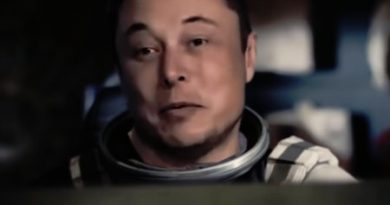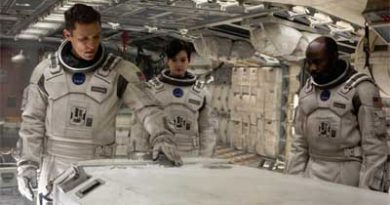Interstellar (2014): a film review by Mark R. Leeper (film review).
With the depth and complexity of a Science Fiction novel, Christopher Nolan brings ‘Interstellar’ to the screen, based on an original screenplay he wrote with his brother, Jonathan. As the last-ditch effort of our dying civilization, a mission is sent through a wormhole to another galaxy in an effort to find an Earth-like planet to be a new home for humanity. No previous Science Fiction film has ever had the scope and span that this film has. It is surprising it all fits into a very tight 167 minutes.
Rating: +3 (-4 to +4) or 9/10.
Christopher Nolan’s ‘Interstellar’ is quite possibly the most complex Science Fiction film with the most ideas of any SF film ever. It starts with a family suffering in what at first appears to be the great 1930s Dust Bowl and spans its way to planets in other galaxies with references to higher dimensions and other universes, not to mention examinations of not one but two father-daughter relationships with, in each case, father and daughter literally, as well as figuratively, light-years apart.
But that is getting ahead of myself. As the film opens, we think we are seeing a documentary about the great 1930s Dust Bowl. We quickly find out that in this near future world, the dust storms have returned to the Great Plains. Blights and haboobs have killed off nearly all major crops. Only corn still survives and its time seems to be limited. Most people are worried, but still make a priority drinking alcohol made from (what else?) corn. The world is counting down to its demise. Cooper (played by Matthew McConaughey) is a corn farmer who was once a very good test pilot for NASA. He is contacted by NASA who wants him back for a mission that might save humanity. One end of a wormhole has appears to have formed near Saturn. There are twelve explorers who were sent out a decade earlier to study Earth-like planets near the other end of the wormhole. But the information they found never made it back to Earth.
Now a mission is being mounted to travel through the wormhole and at the far end to collect what information they can to decide if any of the planets can be a haven for humankind. On the mission will be Amelia Brand (Anne Hathaway), the daughter of a former colleague of Cooper’s. Her father is planning the expedition, called the Lazarus Mission. In the course of the film, we go from cornfields to wormholes to black holes to the surfaces of two alien planets along with spacecraft and robots, all of which are important to the plot. It is a complex scenario and one that will tax viewers to just follow what is happening. All of this nearly takes back seat to a story that is mostly about strained family relations. The viewer should expect that with everything else going on there is a good deal of tearful apologies. It is an unimaginable feat of storytelling to juggle so many elements and keep them all in the air at once.
In a film with this many ideas packed together, some have got to be a little on the funky side. It takes our astronauts two years just to get to Saturn and the wormhole, yet at the other end of the wormhole there are no less then twelve superficially habitable-seeming planets all within striking distance, like Starbucks near a subway stop. TARS, their robot (voiced by actor Bill Irwin), is a very new and a very original-looking design for a robot. TARS steals every scene he/she/it is in by being so interesting. Back in the 1940s film robots looked boxy, but not nearly as boxy as TARS. On the corny side is that suggestion that love has some special trans-dimensional implications and, speaking of corn, it is a crop very susceptible to droughts. It is unlikely that corn could grow in a region suffering from dust bowl conditions.
Besides Matthew McConaughey and Anne Hathaway, the film features Jessica Chastain, Michael Caine, Ellen Burstyn, Casey Affleck, John Lithgow and more.
Not everything is so wonderful about this film. My major complaint with the film, however, is that the sound editing is a mess. With the complexity and techi-ness of the talk, it is important to hear every word. The sound is, however, muddy and indistinct, and at times the music and sound effects tracks overpower the dialogue track. Also, occasionally the actors just don’t project their voices. I look forward to getting the film on disk so I can turn on subtitling. After ‘2001: A Space Odyssey’ set the standard for scenes of hyper-light travel and ‘Contact’ had its own sequence, the wormhole travel depiction us just a bit uninspired, though the depiction of the black hole is fairly accurate.
‘Interstellar’ is more than just a Science Fiction story for the screen, it is a novel aimed at adults with a novel’s complexity. This is probably the most audacious Science Fiction film anyone has ever made or even tried to make. I rate it a +3 on the -4 to +4 scale or 9/10.
Mark R. Leeper
© Mark R. Leeper 2014






